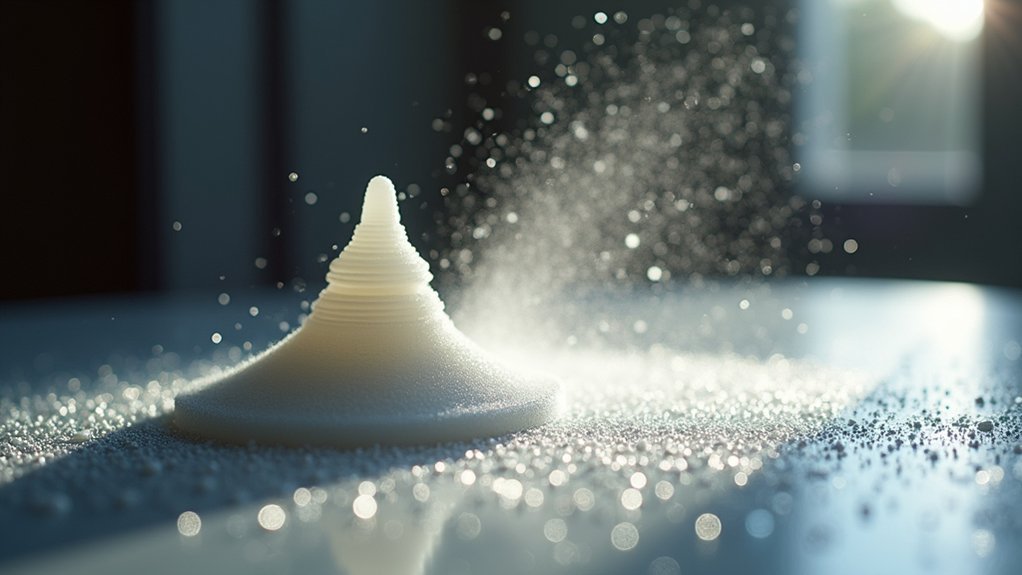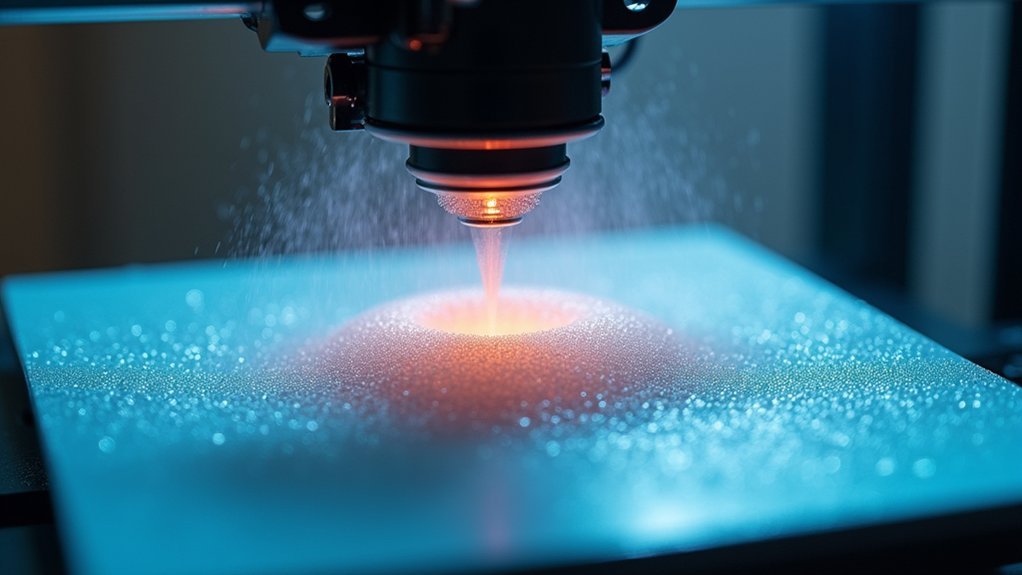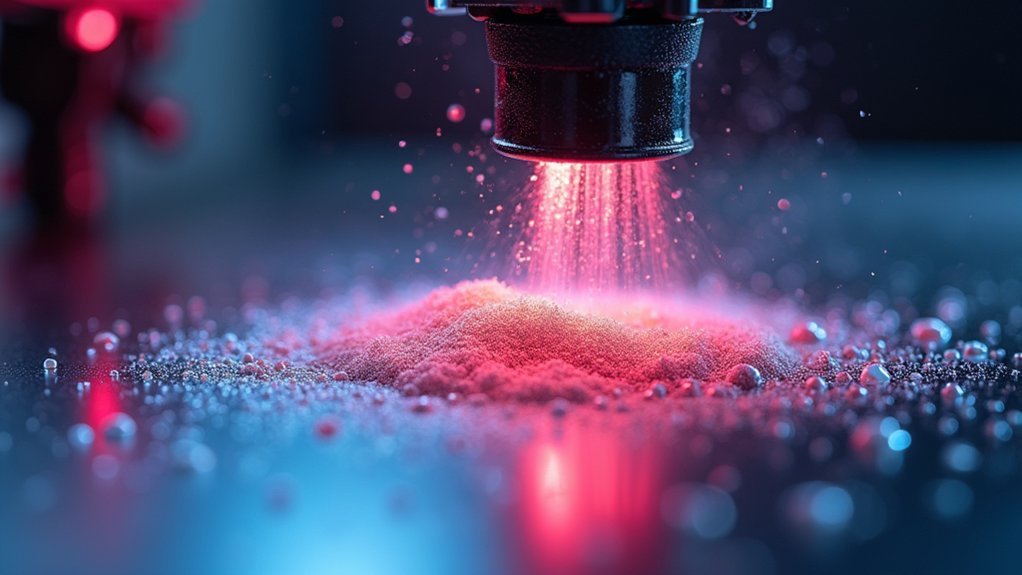Hairspray improves 3D print adhesion through its polymer-based formula that creates a sticky, textured film on your print bed. When you spray it, the high alcohol content evaporates quickly, concentrating adhesive polymers that form molecular bonds with your filament through van der Waals forces. The textured surface increases mechanical interlocking with first layers, while heated beds around 50°C activate the adhesive properties for stronger bonding. Understanding proper application techniques and safety considerations will maximize your printing success.
The Science Behind Hairspray’s Adhesion Properties

While many 3D printing enthusiasts reach for expensive bed adhesion solutions, hairspray works surprisingly well due to its unique chemical composition.
Hairspray’s polymer-based formula offers an affordable alternative to costly commercial bed adhesion products for 3D printing applications.
When you spray hairspray onto your heated print bed, the polymers within create a sticky film that enhances adhesion between your filament and the surface. The high alcohol content dissolves these polymers and evaporates quickly, leaving behind an effective adhesive layer.
You’ll find that hairspray provides a textured surface that increases mechanical interlocking with your first layers. Stronger hold varieties contain more robust polymers, making them particularly effective.
As your print cools down, the hairspray becomes less sticky, allowing you to remove finished objects easily without damaging your print bed’s surface.
Alcohol Content and Surface Tackiness Creation
When you spray hairspray onto your print bed, the high alcohol content immediately begins evaporating, leaving behind the polymer components that create adhesion.
This evaporation process happens quickly due to alcohol’s low boiling point, concentrating the sticky materials on the surface.
As the alcohol disappears, you’re left with a tacky residue that transforms your smooth print bed into an adhesive surface perfect for anchoring your first layer.
Alcohol Evaporation Process
As soon as you spray hairspray onto your heated print bed, the alcohol content begins its vital evaporation process that transforms a liquid coating into an effective adhesive surface.
The warm bed temperature accelerates this alcohol evaporation process, causing the alcohol to quickly vaporize and leave behind polymers and sticky residues. You’ll notice this transformation happens within seconds as the liquid hairspray becomes tacky.
The heat from your print bed is fundamental for ideal results. Without sufficient warmth, the alcohol evaporation process slows dramatically, preventing proper adhesive formation.
As alcohol molecules escape into the air, they concentrate the remaining polymers, creating that vital sticky layer. This rapid evaporation guarantees your first print layers bond immediately upon contact with the prepared surface.
Tacky Residue Formation
Once the alcohol evaporates from your hairspray application, you’re left with a concentrated layer of polymers and resins that forms the tacky residue essential for print adhesion. This sticky surface creates the perfect interface between your print bed and filament’s first layers.
The tacky residue works by providing mechanical grip that prevents warping and lifting during printing. Heat from your print bed activates this stickiness, making the hairspray even more effective at holding your prints in place.
| Temperature Range | Tackiness Level | Adhesion Quality |
|---|---|---|
| Room Temperature | Low | Basic |
| 40-50°C | Medium | Good |
| 60-70°C | High | Excellent |
| 80-90°C | Maximum | Superior |
| Above 100°C | Reduced | Variable |
Consistent application guarantees uniform tackiness across your entire print surface.
Polymer Bonding With Filament Materials

You’ll find that hairspray’s polymer chains create direct molecular interactions with your filament materials through van der Waals forces and mechanical interlocking.
The chemical adhesive properties work because the polymers in hairspray can form temporary bonds with the heated thermoplastic as it cools and hardens on your print bed.
Your success depends heavily on material compatibility factors, since different filaments like PLA, ABS, and PETG each respond uniquely to the specific polymer formulations found in various hairspray brands.
Polymer Chain Interactions
When you apply hairspray to your print bed, the polymers within it don’t just create a sticky surface—they actively form temporary chemical bonds with your filament’s polymer chains. This molecular interaction creates a stronger foundation than simple mechanical adhesion alone.
The effectiveness of these polymer chain interactions depends heavily on your filament material:
| Filament Type | Interaction Strength | Adhesion Quality |
|---|---|---|
| PLA | High | Excellent |
| ABS | Moderate | Good |
| PETG | Variable | Fair to Good |
When your heated bed warms the hairspray, its polymers become more pliable and can interlock more effectively with your filament’s polymer chains. This enhanced molecular contact area considerably improves grip during printing, while the weakening bonds during cooling facilitate easier print removal.
Chemical Adhesive Properties
Beyond the physical interlocking described earlier, hairspray’s chemical composition creates specific adhesive properties that directly influence how well your filament bonds to the print bed. The polymers in hairspray form molecular bonds with your printing material, creating stronger adhesion than surface texture alone.
When heated, these polymer chains become more flexible and reactive, allowing them to penetrate microscopic irregularities in your filament’s surface layers.
Different filament materials respond uniquely to hairspray’s chemical properties. PLA and ABS typically achieve excellent bonding due to polymer compatibility, while more specialized materials may require different adhesion solutions.
The alcohol carrier evaporates quickly, concentrating the active polymers where you need them most – at the critical interface between your print and the bed surface.
Material Compatibility Factors
While hairspray’s polymers create universal adhesion benefits, the strength and durability of these bonds depend heavily on your specific filament material. PLA and ABS demonstrate exceptional compatibility with hairspray due to their molecular structure, which forms strong chemical bonds with the spray’s polymer compounds.
When you’re printing with PLA, the hairspray creates particularly reliable adhesion because of complementary polymer interactions. ABS also responds well, though it requires slightly different application techniques.
Other filament types show varying degrees of compatibility. PETG generally works well with hairspray, while specialized materials like TPU may require additional considerations.
You’ll achieve ideal results by understanding how your chosen filament’s chemical composition interacts with the hairspray’s polymers, allowing you to adjust application methods accordingly.
Temperature-Dependent Adhesion Characteristics

Since hairspray’s effectiveness varies greatly with temperature, understanding how heat affects its adhesive properties can dramatically improve your 3D printing success.
When you heat your print bed to around 50°C, the hairspray becomes more viscous and creates a stronger bond with your filament’s first layer. This enhanced adhesion prevents warping and separation during printing.
The warm temperature activates the adhesive components in hairspray, making it tackier and more effective at gripping your print surface.
However, once you’ve finished printing and cool the bed, the hairspray’s adhesive properties diminish considerably. This temperature change works to your advantage, allowing easier print removal without excessive sticking or damage to your printed model.
Choosing the Right Hairspray Formula for Maximum Hold
How do you select the perfect hairspray formula when countless options line store shelves?
You’ll want to target level 10 or “extreme hold” products that deliver maximum adhesion to your print bed. Skip lightweight or flexible formulas—they won’t provide the stickiness you need and could cause print failures.
Before purchasing, check compatibility with your specific printing materials. User reviews and product descriptions often reveal effectiveness on different filament types.
Research compatibility with your filament materials before buying—user reviews reveal which formulas work best for different printing applications.
While off-the-shelf hairsprays vary in performance, specialized options from local 3D print shops typically offer superior results.
Aquanet Extra Hold stands out as a community favorite, delivering reliable adhesion properties when applied to heated print beds.
This trusted hairspray consistently helps makers achieve successful prints.
Proper Application Techniques for Even Coverage
Once you’ve selected your ideal hairspray formula, mastering the application technique determines whether you’ll achieve consistent print adhesion or face frustrating failures.
Position yourself 6-12 inches from the print bed and spray in sweeping motions to prevent heavy buildup in any area. Apply a thin, uniform layer across the entire surface, including edges and corners where prints often lift.
After spraying, wait 30 seconds to 1 minute, then wipe off excess with a paper towel to create an ideal adhesive layer.
Clean your print bed regularly to prevent residue buildup that interferes with new applications.
Test the surface stickiness after application—a properly prepared bed should feel tacky, confirming you’re ready for successful printing.
Safety Considerations and Flammability Risks
While hairspray effectively improves print adhesion, you must understand the serious flammability risks associated with its use in 3D printing environments.
Hairspray contains alcohol and volatile compounds that create significant fire hazards when exposed to your printer’s heated components. The aerosolized particles can ignite easily, making proper safety protocols vital for your workspace.
Follow these critical safety measures:
- Never apply hairspray directly inside your printer enclosure to prevent flammable vapor accumulation.
- Guarantee adequate ventilation to disperse hazardous fumes and reduce inhalation risks.
- Keep your printer away from open flames, sparks, and other ignition sources.
- Avoid excessive hairspray buildup on components, which increases flammability and affects printer functionality.
Proper airflow and cautious application will help you harness hairspray’s adhesion benefits while minimizing dangerous fire risks.
Comparing Hairspray to Alternative Adhesion Methods
When choosing between hairspray and other adhesion methods, you’ll find that hairspray consistently outperforms traditional options like glue sticks and blue painter’s tape.
You’ll experience superior adhesion with PLA and ABS materials when you apply hairspray to a warm print bed, creating a stronger hold than alternatives provide.
Unlike messy glue sticks that require extensive cleanup, hairspray offers quicker application and simpler print removal once your bed cools.
You’ll notice improved print quality with sharper corners on support layers thanks to hairspray’s smoother surface finish.
Many users discover they can eliminate brims and rafts entirely when using hairspray, streamlining their printing process.
While blue painter’s tape works for certain materials, it can’t match high-hold hairspray’s reliability and consistent stickiness.
Maintenance and Reapplication Requirements
Hairspray’s superior performance comes with specific maintenance requirements that’ll keep your prints adhering consistently. Unlike permanent bed surfaces, hairspray needs regular attention to maintain its effectiveness across multiple printing sessions.
Here’s your maintenance checklist:
- Reapply every 2-8 prints – Monitor adhesion quality and refresh when stickiness diminishes.
- Test bed tackiness – Touch the surface before each print; reapply if it doesn’t feel sticky.
- Clean residue buildup – Remove excess hairspray regularly to prevent adhesion problems.
- Wait 30 seconds to 1 minute – Allow complete drying after application before starting prints.
Different filament types affect hairspray longevity, so you’ll need to adjust your reapplication frequency accordingly.
Regular monitoring guarantees consistent first-layer adhesion.
Frequently Asked Questions
Why Use Hairspray for 3D Printing?
You’ll use hairspray because it creates a sticky surface on your print bed that prevents your 3D prints from warping or separating during printing, while being much cheaper than specialized adhesive sprays.
How to Increase Adhesion in 3D Printing?
You can increase adhesion by heating your bed to 50°C, applying thin hairspray layers, slowing first layer speed to 20%, and raising bed temperature by 10°C for better sticking.
What Is the Spray for 3D Print Adhesion?
You can use hairspray, specifically brands like Aquanet Extra Hold with maximum hold ratings, as an effective and cost-effective spray for improving 3D print adhesion on your heated print bed.
How to Get 3D Prints to Stick Better?
You’ll get better adhesion by applying strong hold hairspray to your heated print bed, ensuring it’s level, and cleaning the surface regularly. Test different brands and reapply every few prints.





Leave a Reply